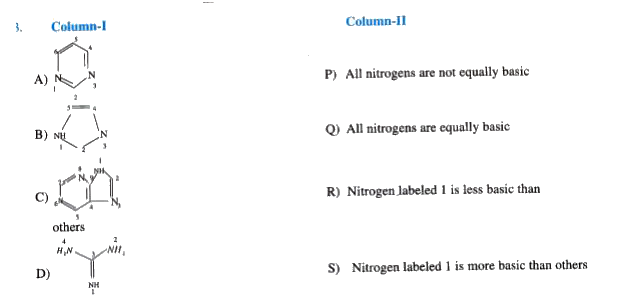Write chemical equations for the following conversions :
C6H5−CH2−Cl into C6H5−CH2−CH2−NH2Solution in Telugu




The correct Answer is:B, C, D
Step by step video, text & image solution for Write chemical equations for the following conversions : C_(6)H_(5)-CH_(2)-Cl " into " C_(6)H_(5)-CH_(2)-CH_(2)-NH_(2) by Chemistry experts to help you in doubts & scoring excellent marks in Class 11 exams.
Topper's Solved these Questions
- BOOK - AAKASH SERIESCHAPTER - ELECTRONIC EFFECTS AND REACTION INTERMEDIATESEXERCISE - LECTURE SHEET - EXERCISE-III (Linked Comprehension Type Questions)6videos
ELECTRONIC EFFECTS AND REACTION INTERMEDIATES
- BOOK - AAKASH SERIESCHAPTER - ELECTRONIC EFFECTS AND REACTION INTERMEDIATESEXERCISE - LECTURE SHEET - EXERCISE-III (Matrix Matching Type Questions)1videos
ELECTRONIC EFFECTS AND REACTION INTERMEDIATES
- BOOK - AAKASH SERIESCHAPTER - ELECTRONIC EFFECTS AND REACTION INTERMEDIATESEXERCISE - LECTURE SHEET - EXERCISE-III (Straight Objective Type Questions)29videos
ELECTRONIC EFFECTS AND REACTION INTERMEDIATES
- BOOK - AAKASH SERIESCHAPTER - ELECTRON MIGRATION EFFECTS EXERCISE - QUESTIONS FOR DESCRIPTIVE ANSWERS10videos
ELECTRON MIGRATION EFFECTS
- BOOK - AAKASH SERIESCHAPTER - ELEMENTS OF BORON FAMILYEXERCISE - OBJECTIVE EXERCISE - 37videos
ELEMENTS OF BORON FAMILY
Similar Questions
Mesomerism is extended resonance. Atoms or groups with lone pairs of electrons release electrons when connected to doubly bonded carbons. It is +M effect. Unsaturated groups when connected to doubly bonded carbons withdraw π electrons from the doubly bonded carbons. It is -M effect. Here the double bond is the unsaturated group should be between less electronegative atom and more electronegative atom.

Mesomeric effect stabilizes or destabilizes the conjugate base of an acid. As a result the acid may be strong or weak has 4(OH) groups. Which -OH is a strong acid?02:00View Solution
has 4(OH) groups. Which -OH is a strong acid?02:00View SolutionMatch the following columns
 17:01View Solution
17:01View SolutionWhich of the following is the strongest acid ?
01:35View SolutionHyperconjugation effect is also termed as 'no bond resonance'. Why?
06:16View SolutionWhich one of the following compounds is not a protonic acid ?
03:11View SolutionWrite chemical equations for the following conversions:
(i)CH3−CH2−ClintoCH3−CH2CH2−NH2
(ii)C6H5−CH2−ClintoC6H5−CH2−NH2View SolutionArrange the following in increasing order of their basic strength:
(i) C2H5NH2,C6H5NH2,NH3,C6H5CH2NH2and(C2H5)2NH
(ii) C2H5NH2,(C2H5)2NH,(C2H5)3N,C6H5NH2
(iii) CH3NH2,(CH3)2NH,(CH3)3N,C6H5CH2NH2.View SolutionComplete the following chemical equations
(i)C6H5N2Cl+C6H5NH2→
(ii)C6H5N2+CH3CH2OH→
(iii) RNH2+CHCl3KOH→01:25View Solutionनिम्नलिखित परिवर्तनों के लिए रासायनिक समीकरण लिखिए-
(i)CH3−CH2−CI से CH3−CH2−CH2−NH2 में
(ii) C6H5−CH2−CI से C6H5−CH2−NH2 में02:00View Solutionनिम्नलिखित को उनके बढ़ते हुए क्षारकीय प्रबलता के क्रम में लिखिए-
(i) C2H5NH2C6H5,C6H5NH2,NH3,C6H5CH2NH2 तथा (C2H5)2NH
(ii) C2H5NH2,(C2H5)2NH,(C2H5)3N,C6H5NH2
(iii) CH3NH2,(CH3)2NH,(CH3)3N,C6H5NH2,C6H5CH2NH217:01View Solutionनिम्नलिखित परिवर्तनों के लिए रासायनिक समीकरण लिखिए -
(i) CH3−CH2−Cl से CH3−CH2−CH2−NH2 में
(ii) C6H5CH2Cl से C6H5−CH2−CH2−NH2 में ।02:35View Solutionनिम्नलिखित को उनके बढ़ते हुए क्षारकीय प्रबलता के क्रम में लिखिए -
(i) C2H5NH2,C6H5NH2,NH3,C6H5CH2NH2,(C2H5)2NH
(ii) C2H5NH2,(C2H5)2NH,(C2H5)3N,C6H5NH2
(iii) CH3NH2,(CH3)2NH,(CH3)3N,C6H5NH2,C6H5CH2NH2.03:11View SolutionWrite chemical equations for the following conversions : C_(6)H_(5)-CH_(2)-Cl " into " C_(6)H_(5)-CH_(2)-CH_(2)-NH_(2)
View SolutionWrite chemical equations for the following conversions: (i) CH_(3)CH_(2)Cl into CH_(3)CH_(2)CH_(2)NH_(2) , (ii) C_(6)H_(5)CH_(2)Cl to C_(6)H_(5)CH_(2)CH_(2)NH_(2) .
06:25View SolutionArrange the following in increasing order of their basic strength:
(i) C2H5NH2,C6H5NH2,NH3,C6H5CH2NH2and(C2H5)2NH
(ii) C2H5NH2,(C2H5)NH,(C2H5)3N,C6H5NH2
(iii) CH3NH2,(CH3)2NH,(CH3)3N,C6H5CH2NH2.View SolutionWrite chemical equation for the following conversions :
(i) CH3−CH2CI→CH2−CH2−CH2−NH2
(ii) C6H5−CH2−CI→C6H5CH2CH2−NH202:53View Solution

